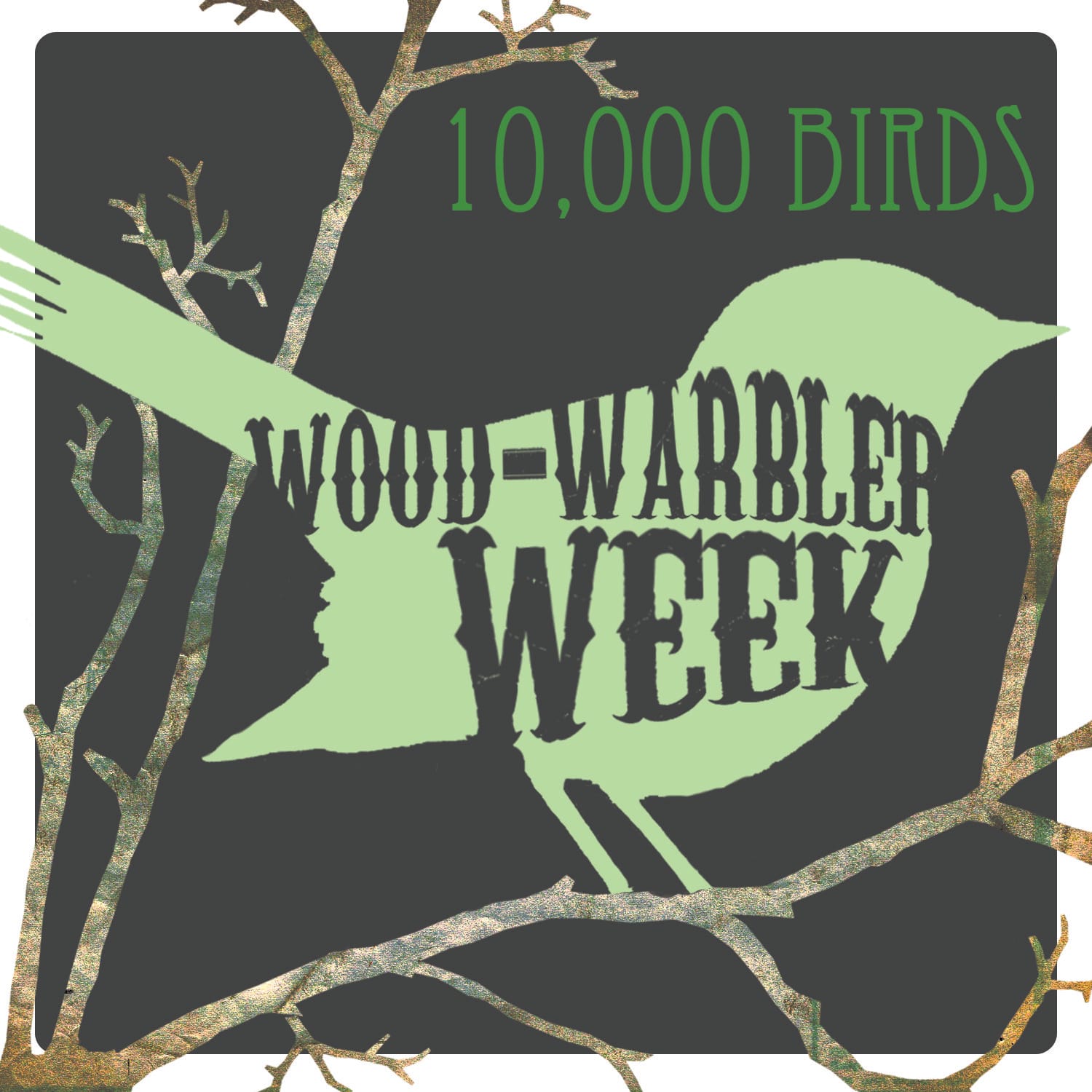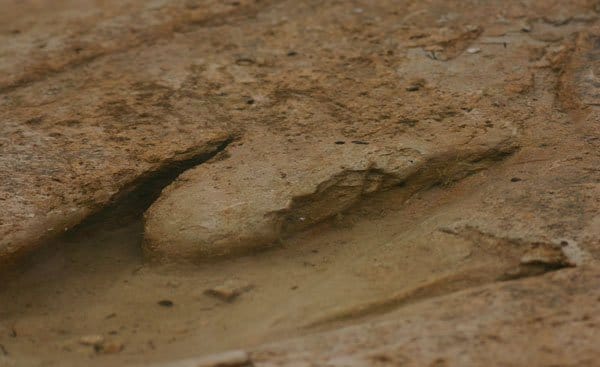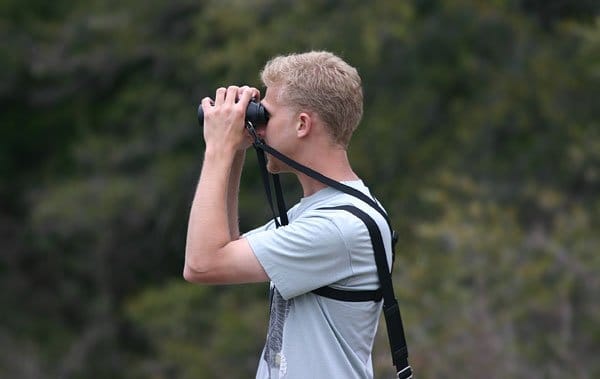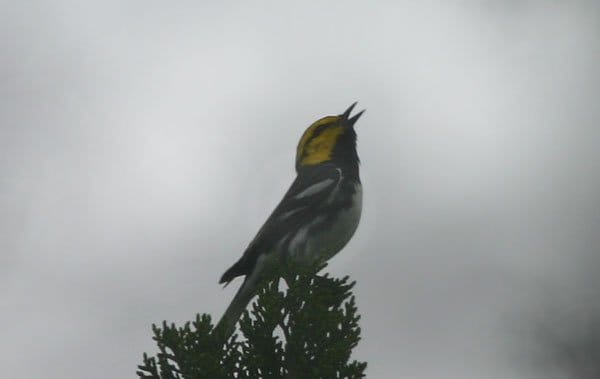GLEN ROSE, TX, MARCH 2007 – The Golden-cheeked Warbler (Dendroica chrysoparia) is one of the United States less accessible avian species. The golden-cheek closely resembles its cousin, the Black-throated Green Warbler, but its coloration is high contrast black, white, and brilliant yellow. This lovely little wood warbler winters in Mexico and Central America, migrating only as far north as a comma-shaped swathe in central Texas to breed. Since I was in Texas, somewhat close to its exotic center, stalking the Golden-cheeked Warbler seemed the sensible, hopefully serendipitous thing to do.
I say serendipitous because this search was all David’s idea. Surely you know David Ringer through his outstanding work at Search and Serendipity, Birdstack, and of course here at 10,000 Birds! Not only is he one of our more contemplative bird bloggers, but his dispatches from far-flung locations like Papua New Guinea have been revelatory. David pointed out that an excursion to Dinosaur Valley State Park would place us right in the path of golden-cheek males returning from their southern sojourns, ready to establish territory by singing in a rather conspicuous manner. We’d also have a shot at the highly coveted Black-capped Vireo and a slew of other regional species. Sign me up!
He wasn’t kidding about Dinosaur Valley’s virtues as an avian oasis (although speaking of kidding, who do the clowns behind the neighboring Creation Evidence Museum think they’re fooling?) We arrived at first light only to be met by a Lark Sparrow, one of the beautiful brown birds on my list of hopefuls. The Lark Sparrow, more boldly marked than many of its compeers, graciously remained still just long enough for me to snap some photos.
Our search for the Golden-cheeked Warbler took us up into some spectacular habitat. Here, the Ashe juniper the golden-cheek requires covers a rocky, cactus- and oak-studded ridge with fragrant, luxuriant growth. This tree, known also as the mountain cedar, has spread beyond central Texas to bedevil ranchers and landscapers alike, but the endangered warbler that depends on it has not. Along the trail, we encountered numerous juncos, cardinals, mockingbirds, White-eyed Vireos, Carolina Chickadees, both Golden- and Ruby-crowned Kinglets, and some rather interesting titmice. This area is where the range of the Tufted Titmouse intersects with that of its Black-crested kin. Kissing cousins is more like it since the titmice we spotted possessed traits of both species. These intermediates were more dominant Black-crested, which makes them good enough for my life list. Who am I to judge?
Our plan of attack had us ascending to the top of the ridge while listening for the golden-cheek’s distinctive, buzzy call, a song that was music to our ears when we first heard it. Trying to put the face to the voice became much more difficult than anticipated as the birds we sought traced an unpredictable path through the trees. We would no sooner track a singing male to a tree than it would disappear for twenty minutes at a time. Even when we did manage to get to the bird’s perch, we couldn’t get as much as a glimpse of it through the thick, evergreen growth. How impenetrable were these dark, towering bushes? To give you an example, we were surrounded at all times by Black-and-white Warblers, easily one of the most visible of the wood-warbler family. In two hours, we spotted only one shadowed individual.
We fought the good fight. I can assure you of that. But every time we reeled this big fish in, it got away again. That saucy miscreant teased us, taunted us, froze us in place, but also eluded us at every turn. After a while, I strongly suspected a malign genius at work, as if the Golden-cheeked Warbler were, in fact, a will-o’-the-wisp determined to lead us over a cliff. Seeking to avert our doom and salvage the expedition, we abandoned the ridge to search for the Black-capped Vireo.
The habitat favored by the vireo was more of a dry savannah carpeted by dry desert grasses, midsize bushes, early flowers, and lots of cactus. Live oaks dotted the flat terrain, but didn’t seem to shelter any vireos. A slew of sparrows enjoyed the area, though, including Field, Lincoln’s, Song, White-crowned, Rufous-crowned, and Vesper, those last lovely two new to me. We heard boatloads of Bewick’s Wren, but saw only bright Carolina, as well as Eastern Phoebe, Eastern Bluebird, Purple Martin, Bank Swallow, Spotted Towhee, Blue-gray Gnatcatcher, and Red-bellied Woodpecker, but no vireo.
Having given up on one bird, we were on the cusp of abandoning another. The gray, drizzling day was fun, but a long drive lay ahead. Just as we were about to turn around, we heard that mocking song that had been seared into our brain by the morning’s frustration. A Golden-cheeked Warbler was very near! We gave chase, pursuing our elusive, unseen quarry as it led us down a long trail. Every time we got close, it moved further along, probably hoping to land us in quicksand or a mess of fire ants. But just when all seemed lost, when our quest seemed destined for more abject failure, I caught a glimpse of the bird. More than a glimpse, I got a perfectly framed view of a dazzling male Golden-cheeked Warbler in full song. In no time, David got the golden-cheek too. For a full minute or more, we enjoyed this beauty with its flashing cheeks and jet black hood. Consider the Golden-cheeked Warbler, a true North American rarity, stalked.
————————————————————————————————————————————————
 This week, 8 May – 14 May 2011, is Wood-Warbler Week on 10,000 Birds! Though wood-warblers, the mostly brightly colored birds of the family Parulidae, are only found in the New World we felt that birders the world over would be pleased to see a plethora of posts about these striking and sought after species. We are devoting a whole week to wood-warblers but are only just barely scratching the surface of possible topics involving this amazing family of birds.
This week, 8 May – 14 May 2011, is Wood-Warbler Week on 10,000 Birds! Though wood-warblers, the mostly brightly colored birds of the family Parulidae, are only found in the New World we felt that birders the world over would be pleased to see a plethora of posts about these striking and sought after species. We are devoting a whole week to wood-warblers but are only just barely scratching the surface of possible topics involving this amazing family of birds.
Right now great flocks of wood-warblers are making their way north from the southern United States, Mexico, the Caribbean, Central and South America to breed across the United States and Canada. Many other non-migratory wood-warbler species are living their lives across the neotropics, doing their best to survive and pass on their genes. Wood-Warbler Week is a celebration of all wood-warblers and we hope you join us in celebrating these absolutely wonderful birds. Read about them here but also get out and experience them. You won’t regret it!
————————————————————————————————————————————————
















Congratulations Mike! An outstanding catch. I’m delighted your Texas sojourn is being so productive. I was fortunate enough to spot a Golden-cheeked in Belize a number of years ago. I believe it to be the rarest bird on my life list.
Excellent! Puts me in the right frame of mind for the return of the wood warblers–maybe this year I’ll get my eyes on some that have sung for me in the past, but never emerged from the foliage.
Bring some warblers back with you, would you? I miss them…
And congrats on a well-earned lifer!
Congrats, Mike! What a fun tale to read.
Great recap of your search. Congrats!
Very nice tale and congratulations on seeing such a beautiful bird!!
I still haven’t seen a single warbler here in Michigan this year, so I even envy you for your black-and-whites, not to mention the golden one.
Great shot of the warbler. I’ve never seen one and I live in central Texas, of course, I’ve only started traying identify them.
It’s interesting that you mention the black-crested tufted titmouse as that was the subject of arecent post on my blog. (Link here, if you’re interested.)
Mike, thanks for letting me know about the distinction between the black-crested and tufted titmouse. I’ve updated my post accordingly.
Yaaay!! Well done Mike. And you even got a photo!
Congrats on the GcW. I am green with envy. I chased one/several all over Frederick Park outside of San Antonio in March. It was always just out of reach. It could have been the same one! LOL. Nice photo.
Everybody loves GCWA! I’ve been studying them for my master’s thesis for the last two years. Central Texas is a great place for birds. For anyone looking for these little buggers, finding these adorable Warblers is a lot easier in the Southern portion of the range where there is more unfragmented habitat and high densities of breeders. I highly recommend a short hike along the trails or old park roads at Garner State Park in Uvalde County. Lost Maples State Park is the preferred spot for tour groups visiting the area, and is a great spot for other migrants as well!
We had a wonderful greenbelt in our neighborhood in Austin where we enjoyed seeing golden cheeked warblers. I am a little surprised at your mocking disdain of the Creation Evidence Museum in Glenrose without having checked it out. It’s actually quite an interesting place with lots of good science!
Kim, just from looking at the website I seriously doubt anything that could remotely be called good science is in display at that place. Any science museum that quotes biblical verse as settled fact is not a place good science is done.
Glad you get to enjoy the warblers though.
Well, Corey, I guess if you knew the Bible well, you would know that it does not contradict science. There is a definite anti-evolution bent at the Creation Evidence Museum. But there are many notable scientists, both believers in God and nonbelievers, who do not believe that life has evolved over millions of years. They are the subject of the recent documentary, “Expelled,” starring Ben Stein. (They and their work are routinely expelled from prestigious scientific circles, because to question the holy dogma of evolution is not permitted. Sounds a little Orwellian, doesn’t it?) I think good science welcomes questions. And that little museum has a passionate scientist at its helm.
Kim, I was raised in a Protestant church and knew the bible well enough by the time I was 14 to know it is not the word of god and is not fact.
The Ben Stein movie is crap (he tried to blame Darwin for the Holocaust!) and it is not Orwellian for scientists to expect other scientists to use the scientific method, not blind faith.
I’m not going to continue to debate with you on this because it is clear that you have your mind made up and wish to remain as ignorant as the folks who run the Creation Evidence Museum.
Corey, I understand that you do not wish to debate or argue and that is not my intent. But to say that anyone who believes the Bible is ignorant is arrogant and actually an ignorant idea itself. Some of the most brilliant minds in history have been Bible believers and not because it was spoon-fed to them, but because they examined it piece by piece and decided for themselves. (Isaac Newton and C.S. Lewis come to mind, off the bat.) Perhaps I am misreading you, but your passion communicates anger. Perhaps you were hurt by people who claimed to be Christians. I am sorry for the harm that was done to you. Take care and enjoy those golden cheeked warblers.
Golden Cheeked Warblers are on the increase on my property! (that’s the bad news) I have lived on Backbone Ridge near the Longhorn Cavern in Central Texas for the past seven years. Each year along Park Road 4, more rural subdivisions pop up, and clear large sections of land. The more Juniper they clear, the more Warblers arrive at my place. They virtually have no place left to go. I now have the largest old growth Junipers in the area. I also participate in trapping the Brown Headed Cow Bird, which assists the nesting of the GCW. In the spring, I have no trouble seeing the GCW from my front porch!
However, in the Spring we also have huge Rattlesnakes that have adapted to this area. They feed on lizards, and climb the Junipers in pusuit of their prey. You must not only watch where you step, but also watch the lower branches. That is why I prefer to watch birds from my porch.
J,R, that’s both amazing and unfortunate. It’s no wonder GCWs, with their specific habitat requirements, are becoming more and more scarce.
I just put a contract on a home in hill country New Braunfels and the only disclosure on the home was that we had the golden cheek warbler habitat at the end of the property and we could not disturb them. Can you tell me a little about this beautiful bird! Pamie G.
Pamela, the issue with the Golden-cheeked Warbler is that its numbers are diminishing every year due to habitat fragmentation and destruction. According to BirdLife International, the population is down to about 21,000. Golden-cheeks breed only in the Hill Country and then only in juniper-oak habitat. So if you’ve got some, please keep it intact!
I am very excited to help with their habitat. We promise to be very careful in cleaning the property and not cutting down anything in that area. I hope I see them!!!!
What does one sound like?
I just heard a Golden-cheeked Warbler in the Ashe Juniper choked canyon behind my house in NW Austin. It’s a thrill to hear the distinctive buzzy call. They are definitely hard to see. The only perfect sighting I have had was one in the parking lot(!) at Pedernales Falls. http://www.xeno-canto.org/XCspeciesprofiles.php?species_nr2=3681.00 is a good site for recordings. I fear for my population because the city is starting a 3 year excavation project right next to their habitat.